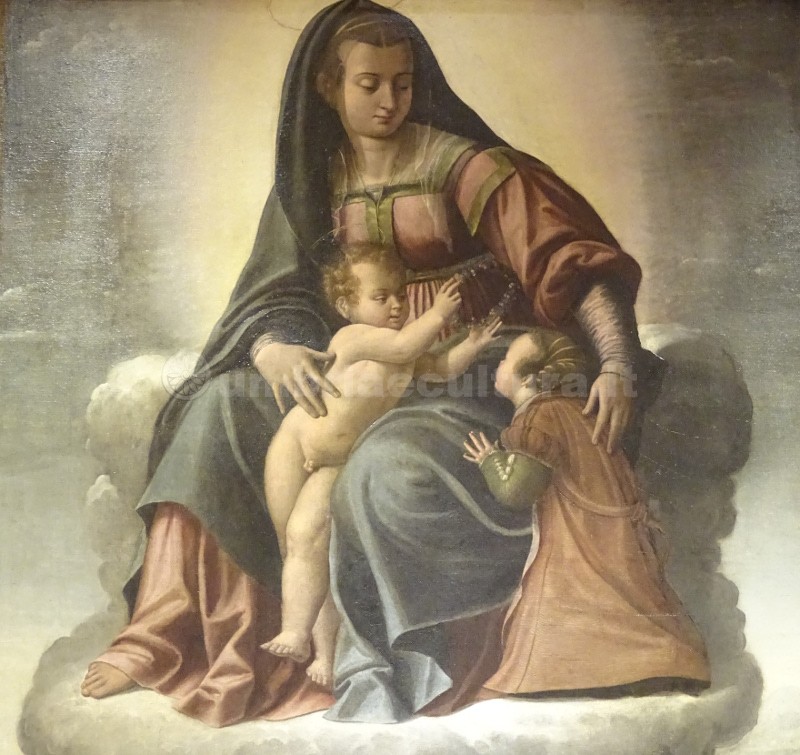Already in the entrance, the Civic Museum of Bevagna testifies the ancient origins of the town, thanks to the exposed stone artefacts of Roman origin, found in the area and collected by the abbot Fabio Alberti in the 18th century. The town, known for the Mercato delle Gaite, the appointment that celebrates its medieval period, has its roots in the ancient Roman town of Mevania.
A precious object exhibited in the museum, testimony of the devotion of the people of Bevagna, is the chest that contained the body of Beato Giacomo. He was a Dominican monk born in Bevagna in 1220 and died in 1301, that made a lot of miracles during his life, three of them are illustrated on the side of the chest, painted by Ascensidonio Spacca called “il Fantino”.
The iconography of the Madonna of Constantinople is somewhat widespread in the city, where it’s possible to admire three works: one in the Madonna delle Grazie church, one in the church of Beato Giacomo and one in the Civic Museum of Bevagna, painted by Il Fantino: the Madonna indicates the Child (the way to salvation) and the closed scroll in the hands of Jesus which symbolizes the Gospel yet to be written.
Another work by Fantino present at the Museum is the Annunciation where the Madonna, with a submissive gesture, accepts the announcement of the Archangel Gabriel. The detail of the swallow placed on the wire in the background is the sign that the scene happens in March: the Annunciation took place on March 25th, but it is also a symbol of resurrection, almost prophesying what will happen. The iconography of the cat, which generally has negative connotations, is present in this work in order to reproduce an intimate and familiar environment.
Giovanni Battista Pacetti called “lo Sguazzino” is the painter who realized the Trinity and Saints with Blessed Giacomo holding the chalice, San Vincenzo in bishop’s clothes, San Giuseppe and San Filippo Neri. In the painting a detail of the city of Bevagna is reproduced.
The “highlight” of the collection of the Civic Museum of Bevagna, and the best known, is the Adoration of the Magi by Corrado Giaquinto, painted in 1750. The light embraces the scene, gives life to bright colors, and underlines the wonder of St. Joseph for what is happening, giving the composition the mystical atmosphere of a wonderful and supernatural event. Note the detail of the doves in the basket to symbolize Mary’s chastity.
A girl in eighteenth-century clothes is portrayed with an open shell in her hand from which a pearl necklace unravels: a portrait certainly destined to her future husband, with the open shell and pearls symbol of purity and virtue.
The Pala Ciccoli (in the photo, a detail) by Dono Doni, which represents the Madonna and Child in glory crowning Gisberto Ciccoli’s niece, is extremely tender. Ciccoli was an important doctor from Bevagna, and the girl, her only niece, died at the age of 10 for a violent fever. Defeated as a doctor and uncle, Ciccoli commissioned the altarpiece beacuse of his great pain, to make the figure of the niece immortal, whose name is not written, represented next to the Virgin and Jesus in the act of crowning her. In the upper part of the composition the Virgin is depicted, seated on a throne with clouds, welcoming the little girl with a hug and a loving mother’s gaze.
In the lower part of the work, some cartouches tell what happened, the reason of the work and the deep pain of the client. The altarpiece was painted for a chapel of the church of San Francesco dedicated to the Immaculate Conception, because the girl, torn early from life, died immaculate.
A real gem is the model of the Madonna delle Grazie Sanctuary, the wooden model opens completely and the interior is faithful to the construction of the sanctuary, while the bell tower is different from the real one. The Sanctuary was built on top of a votive shrine dedicated precisely to the Madonna delle Grazie, at the point where the miracle of Pancascio’s healing took place. Pancascio was a man from Bevagna who lived in Rome, it is said that, very ill, he went on a journey because, before dying, he wanted to see Bevagna once again and, once he arrived at the place where the sanctuary stands, he suddenly recovered through the intercession of the Madonna, for thanksgiving he wanted the shrine to be built and, after other miraculous events, it was replaced by the Sanctuary.
Benedetta Tintillini
Find Bevagna Civic Museum on Google Maps:



